Introduction
The conehead termite, Nasutitermes corniger (Motschulsky) (Figure 1), is the first record of a non-endemic establishment from the family Termitidae in the United States (Scheffrahn et al. 2002). This widespread Neotropical species is unique among Florida termites due to the soldier's nasus (an elongated frontal projection on the soldier's head) and conspicuous nests (Scheffrahn et al. 2002). These termites are able to feed on many species of wood, i.e., structural wood and dead wood on living trees, and they inhabit a wide range of habitats. The conehead termite is of economic importance (Scheffrahn et al. 2014).
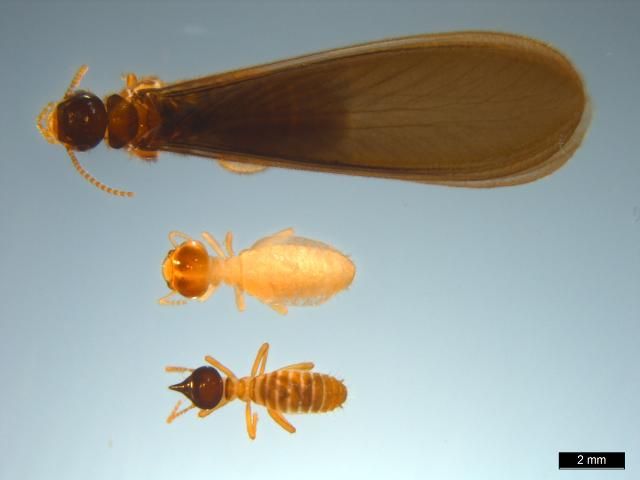
Credit: Reina L. Tong, UF/IFAS
Molecular analysis comparing Nasutitermes corniger and Nasutitermes costalis (Holmgren) reveal that these species, previously only distinguishable by locality, are the same (Scheffrahn et al. 2005). Morphological, biological, behavioral and other ecological data support the synonymy, leading to the revision of the distribution of this species. The senior synonym, Nasutitermes corniger, was given precedence. The common name for this termite has also changed. It has been referred to as the tree termite, due to its arboreal nests, and the coneheaded termite, due to its head shape; however, the approved common name for Nasutitermes corniger is the conehead termite.
Distribution
In the US, established populations of Nasutitermes corniger were found in Dania Beach, Broward County, Florida, in 2001 (Scheffrahn et al. 2002). Elsewhere, Nasutitermes corniger was first described from Panama, and the native range spans from Mexico, through Central America and South America, as well as the West Indies (Figure 2). This widespread termite can establish in varying tropical habitats, including urban, agricultural, and natural environments (Scheffrahn et al. 2005), and has also been introduced by humans to the Papuan Region.
Description and Identification
Conehead termite soldiers are small, about 5 mm (0.2 in) (Figure 3). Soldiers have brown to black heads with a cone-shaped forward projection, the nasus, that secretes a defensive compound (Lubin and Montgomery 1981) (Figures 3a, 3b). Soldiers of this species have mandibles reduced to small points (Figure 3b) (Thorne 1984). There are six setae (hairs) on the soldier's head; this characteristic, in conjunction with the colony having multiple queens (polygyny) can be used to distinguish Nasutitermes corniger from some other members of the genus Nasutitermes (Figure 3c) (Scheffrahn et al. 2002).
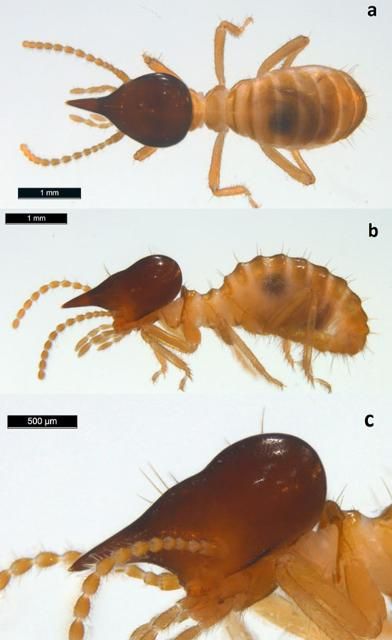
Credit: Reina L. Tong, UF/IFAS
Alates, or winged reproductive adults, have dark brown bodies with dark wings (Howard et al. 1988), and are fairly large (~15 to 18 mm, or ~0.6 to 0.7 in) (Figures 4a, 4c). Two thickened veins are present along the leading edge of the wings, similar to Amitermes floridensis Scheffrahn, Su, and Mangold in the family Termitidaeas well as species in the family Rhinotermitidae. The wings of Nasutitermes corniger are dark brown to black (Figures 4a, 4c). As a widespread termite, morphological variation can be seen in the size of the compound eyes and ocelli (simple eyes) (Scheffrahn et al. 2005) (Figure 4b). Two species of termites in Florida have dark-winged adults, Nasutitermes corniger and Amitermes floridensis. Nasutitermes corniger can be distinguished from Amitermes floridensis by body size including the wings (~15 to 18 mm (~0.6 to 0.7 in) compared to ~9 mm (~0.35 in), respectively).
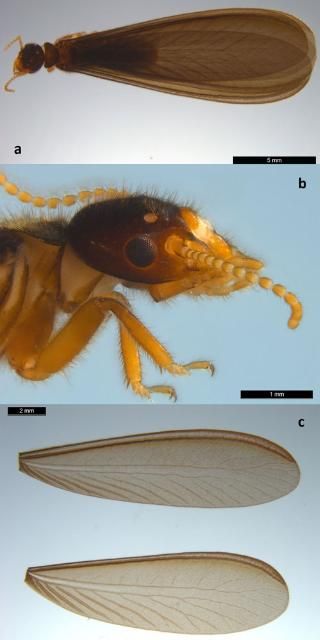
Credit: Reina L. Tong, UF/IFAS
Life History
Nasutitermes corniger colonies generally start as imagos that have paired after leaving their natal nest in a dispersal flight, or swarm. The aboveground nests are often visible and found at the base of trees, on tree trunks or in higher branches (Figures 5 and 6). Ground nests and nests within manufactured structures or debris are also common; however, this termite can vary its nesting locations. They have been found in structures, trash piles, under cement blocks, etc. Some nests may be difficult to locate when covered with vegetation or debris (Scheffrahn et al. 2014). Nests are composed of carton, which is primarily composed of feces (Lubin and Montgomery 1981).
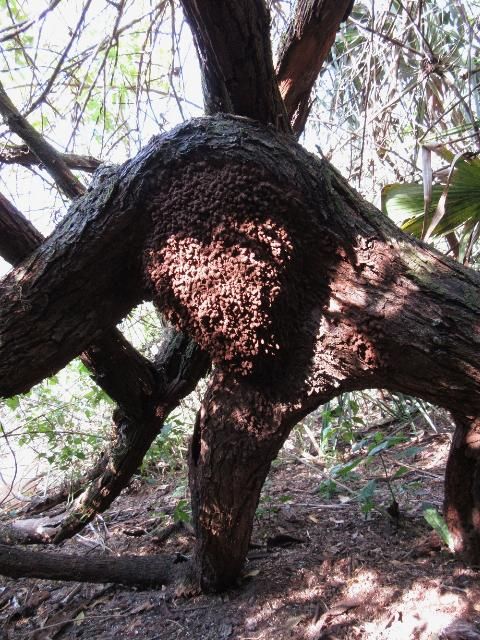
Credit: Katherine Tenn, Florida Department of Agriculture and Consumer Services
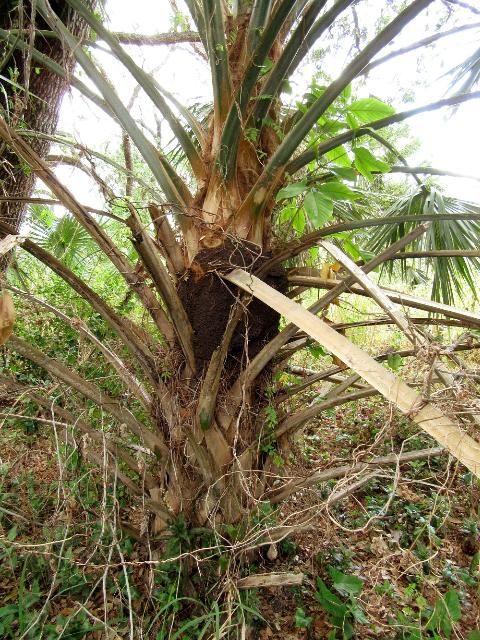
Credit: Katherine Tenn, Florida Department of Agriculture and Consumer Services
Conehead termites construct tunnels or foraging galleries connecting their nesting and feeding locations (Figures 7 and 8). Such tunnels are ~5 mm (0.2 in) or larger in width and hollow, forming a soil tube with a straw-like appearance when broken. These tunnel systems are highly branched, extensive foraging networks and can easily reach over 30 m (~200 in) from a nest.
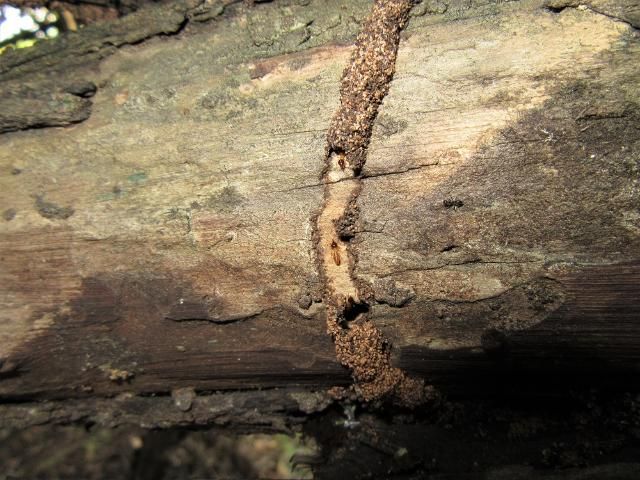
Credit: Katherine Tenn, Florida Department of Agriculture and Consumer Services

Credit: Katherine Tenn, Florida Department of Agriculture and Consumer Services
Castes within conehead termite colonies include reproductives, soldiers, and workers (Thorne and Noirot 1982, Thorne 1984). The colony also contains eggs and immature termites called larvae. Each caste has a specific task within the colony (division of labor).
Soldiers make up about 20% of the colony (Thorne 1984). Soldiers from this subfamily have an advanced defense that can deter ants and even large vertebrates such as anteaters by squirting a noxious defensive secretion from the nasus (Lubin and Montgomery 1981).
Workers have reached a terminal molt. There are two sizes of workers based on sex: large workers are female and small workers are male. Soldiers leave the nest at night and locate food items before recruiting workers, and workers and soldiers leave the nest on exposed surfaces at night (Traniello and Busher 1985). After a trail to a food source is established, the termites will cover the trail with a soil/feces mixture.
Nasutitermes corniger can have multiple reproductives within the colony, including primary reproductives and three types of replacement reproductives: first-form, second-form, and third-form. While there are colonies with only one primary king and one primary queen, colonies with multiple primary kings and queens are common (Figure 9) (Atkinson and Adams 1997). First-form, or primary kings and queens, are derived from alates, possess wing scales, and include the original founding pair as well as adultoids, which are mature alates that have dropped their wings within their natal nest and remain to contribute to reproductive output; these have been observed to number up to 33. Multiple primary kings and queens may be a result of a group of winged imagoes nesting together at colony foundation. Second-form reproductives follow the same developmental pathway as primary reproductives, but they never form membranous wings (but have wing pads), and always remain in their natal nest.
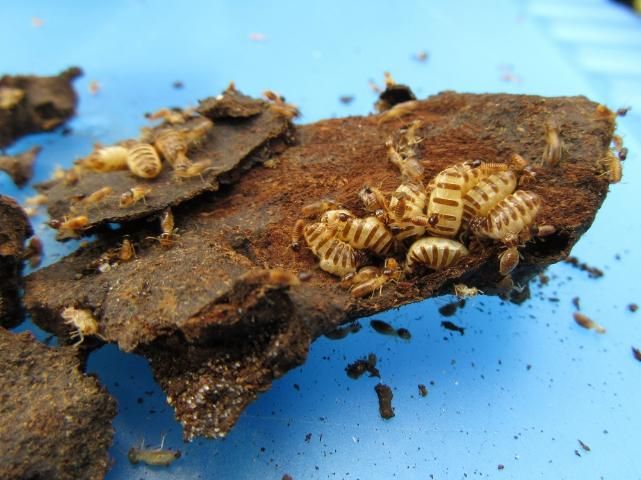
Credit: Katherine Tenn, Florida Department of Agriculture and Consumer Services
Third-form reproductives are derived from workers, have no wing buds, are unsclerotized, and have non-functional or absent compound eyes. Both second and third-form reproductives have lower egg-laying capacity than primary reproductives, and are usually formed after the death of or isolation from one or both of the original primary reproductives. Older colonies can have carton satellites connected by mud tubes or tunnels, with the kings and queens mobile between sites (Scheffrahn et al. 2005), and adultoids in these satellites supplement the original founders rather than replace them. Isolation of satellite nests can result in colony budding, in which a new colony forms that is disconnected from the original colony.
Colonies of Nasutitermes corniger reach maturity when the colony grows to over 50,000 workers and soldiers (Thorne 1984). After reaching maturity, the conehead termite swarms annually during the rainy season (May to November), usually after precipitation (Scheffrahn et al. 2005, Thorne and Noirot 1982). Colonies can number 800,000 to over 1.2 million individuals in a large colony (Thorne and Noirot 1982).
Damage
Nasutitermes corniger consumes both dry and wet wood, including decayed wood, as well as both hard and soft wood (Scheffrahn et al. 2005). This termite also consumes trees and dead branches, dead palm leaf axils, bamboo, etc., and will consume structural (e.g., load-bearing) and non-structural wood (e.g., plywood, framing, trim) (Scheffrahn et al. 2005). Evidence of an infestation includes the nest itself (Figures 5 and 6) and tunnels on structures or nearby vegetation, although tunnels are often more numerous and easily visible than nest locations as they are surface feeders and cover their feeding sites with carton (Figures 7 and 8).
Pest Status
Nasutitermes corniger likely arrived in Florida from an infested ship, cabin cruiser, yacht, or pleasure boat (Scheffrahn et al. 2002). The conehead termite is considered an aggressive structural pest (Scheffrahn et al. 2014) and is known to eat dead portions of live trees, including fruit trees (Jutsum et al. 1981). The high reproductive output and ability for fragmentation of colonies may affect treatment. Infestations are easily detected in occupied structures and can be treated if the species is correctly identified and all the nests are located. Following treatment, periodic resurveys are needed as young colonies can remain hidden inside wood for several years.
Management
Because the nests of Nasutitermes corniger are usually visible, treatment with non-repellent liquid termiticides is effective (Scheffrahn et al. 2014). Scheffrahn et al. (2014) suggest treating the foraging tubes and previous feeding sites. Heavy structural infestations may also be treated with fumigation (Scheffrahn et al. 2014).
Sightings or infestations may be reported to the Conehead Termite Program, part of the Florida Department of Agriculture and Consumer Services (FDACS) at www.fdacs.gov/Consumer-Resources/Health-and-Safety/Protect-Your-Home-from-Pests/Termites/Conehead-Termite-Program or by going to www.FDACS.gov and searching for "conehead."
Selected References
Atkinson L, Adams ES. 1997. "The origins and relatedness of multiple reproductive in colonies of the termite Nasutiterms corniger." Proceedings of the Royal Society of London, Series B 264: 1131–1136. https://doi.org/10.1098/rspb.1997.0156
Howard RW, Thorne BL, Levings SC, McDaniel CA. 1988. "Cuticular hydrocarbons as chemotaxonomic characters for Nasutitermes corniger (Motschulsky) and N. ephratae (Holmgren) (Isoptera: Termitidae)." Annals of the Entomological Society of America 81: 395–399. https://doi.org/10.1093/aesa/81.3.395
Jutsum AR, Cherrett JM, Fisher M. 1981. "Interactions between the fauna of citrus trees in Trinidad and the ants Atta cephalotes and Azteca sp." Journal of Applied Ecology 18 (1): 187–195. https://doi.org/10.2307/2402488
Lubin YD, Montgomery GG. 1981. "Defenses of Nasutitermes termites (Isoptera, Termitidae) against Tamandua anteaters (Edentata, Myrmecophagidae)." Biotropica 13: 66–76. https://doi.org/10.2307/2387872
Scheffrahn RH, Cabrera BJ, Kern WH, Su N-Y. 2002. "Nasutitermes costalis (Isoptera: Termitidae) in Florida: First record of a non-endemic establishment by a higher termite." Florida Entomologist 85: 273–275. https://doi.org/10.1653/0015-4040(2002)085[0273:NCITIF]2.0.CO;2
Scheffrahn RH, Hochmair HH, Kern WH, Warner J, Krecek J, Maharajh B, Cabrera BJ, Hickman RB. 2014. "Targeted elimination of the exotic termite, Nasutitermes corniger (Isoptera: Termitidae: Nasutitermitinae), from infested tracts in southeastern Florida." International Journal of Pest Management 60: 9–21. https://doi.org/10.1080/09670874.2014.882528
Scheffrahn RH, Krecek J, Szalanski AL, Austin JW. 2005. "Synonymy of neotropical arboreal termites Nasutitermes corniger and N. costalis (Isoptera: Termitidae: Nasutitermitinae), with evidence from morphology, genetics, and biogeography." Annals of the Entomological Society of America 98: 273–281. https://doi.org/10.1603/0013-8746(2005)098[0273:SONATN]2.0.CO;2
Thorne BL. 1984. "Polygyny in the Neotropical termite Nasutitermes corniger: Life history consequences of queen mutualism." Behavioral Ecology and Sociobiology 14: 117–136. https://doi.org/10.1007/BF00291903
Thorne BL, Noirot C. 1982. "Ergatoid reproductives in Nasutitermes corniger (Motschulsky) (Isoptera: Termitidae)." International Journal of Insect Morphology and Embyrology 11: 213–226. https://doi.org/10.1016/S0020-7322(82)80006-8
Traniello JF, Busher C. 1985. "Chemical regulation of polyethism during foraging in the neotropical termite Nasutitermes costalis." Journal of Chemical Ecology 11: 319–332. https://doi.org/10.1007/BF01411418